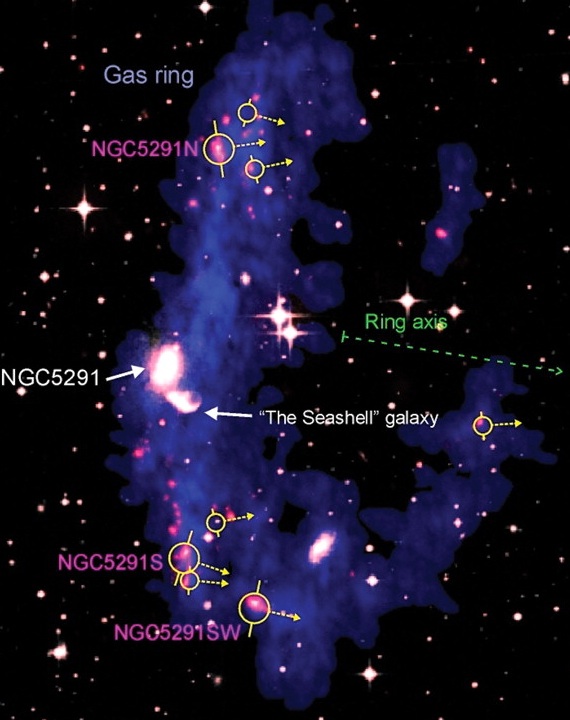


That galaxies can form in the debris from the collisions of other galaxies and not just as primordial objects is of interest in itself. (Indeed, I was myself rather skeptical of this proposition until this latest work of Bournard et al., and you have to read the extensive on-line addenda and not just the short article in Science.) However, it may provide a fundamental test of the dark matter paradigm.
One of the challenges in evaluating the comparative value of dark matter and MOND is that they make their most solid predictions in very different regimes. In individual galaxies, where MOND makes its sharpest predictions (that have largely been confirmed), the presence of dark matter is merely an inference with no specific expectation value. More specific predictions are now provided by structure formation simulations in ΛCDM. These lead to the NFW halo, which fails miserably. But that is only the beginning of the story; any number of physical effects can (and at some level should) impact the final observable mass distribution. The problem is that once we go down this path, anything goes. We know ΛCDM has to be right, so it must work out. Just like Dr. Evil's execution schemes.

One hint is the fine-tuning required to explain rotation curves. It aint good enough to just say "dark matter does it"; one needs to explain all the systematic scaling relations. That boils down to reproducing the MOND phenomenology. Nothing could be less natural for dark matter; it leads to an endless series of epicyclic fixes to the nominal expectation of a baryonic disk embedded in an NFW halo. That seems pretty bad, but does it amount to an outright falsification? [see Sanders 2009.]
Indeed, how would one falsify dark matter? If the current laboratory experiments fail to detect WIMPs in the region of parameter space expected for them, does that do it? Hardly: we just tweak the theory, and move the bar.
It would therefore be quite useful if there were a test that could subject dark matter to falsification. Tidal dwarfs might provide such a test. The reason is that these dwarfs form from tidal debris - material that is pulled out of the baryonic disk of a spiral galaxy. These debris form structures like rings (as in the case pictured above) because they are dynamically cold: they have a very specific phase space structure. [Phase space is the six dimensional space consisting of the usual 3 positional dimensions plus another 3 velocity dimensions. Each star (or gas particle) has an orbit that is specified by it location and speed - i.e., its phase space coordinates.]
The phase space of dark matter is very different from that of the cold gas that gives rise to tidal dwarfs. Instead of the smooth, nearly circular orbits confined to a 2D plane characteristic of gas disks, dark matter particles have highly elliptical orbits spread out in 3D. This is what is seen in simulations of the dark matter, and it must be this way in order for the halo to stabilize the disk. As a consequence of this difference in phase space, very little dark mass should end up in the tidal dwarfs. Hence there is a strong expectation that these objects should exhibit purely Newtonian behavior. What you see is all you get, and they should have declining rotation curves (see Figure from Gentile et al. Red lines are what these dwarfs should do; black points are what they actually do. Black lines are the expectation in MOND.)
Contrary to our expectation in the context of dark matter, Bournard et al. find that the tidal dwarfs they identify do show mass discrepancies. Their rotation curves become flat rather than fall. They attribute this to a second, disk-based component of baryonic dark matter (very cold molecular gas). Even if this component is present (which is astrophysically implausible), I see no reason why it should organize itself in the tidal debris to give the required flat rotation curves. Rather, I'd expect it to behave like the observed baryons, and thus boost the amplitude of the Newtonian rotation curve, but not alter its shape. Perhaps this is consistent with the data, but I find it noteworthy that the tidal dwarfs behave exactly as they should if subject to the MOND force law. More importantly, they show the need for dark matter where there should be none: we need to invoke not one but two distinct kinds of dark matter.
Does this falsify CDM? Would anything?
One "out" I have heard suggested for this problem is sub-halos. ΛCDM simulations show that the dark matter halos of big galaxies should contain very many sub-halos. These would be appropriate to serve as hosts for the tidal dwarfs.
Sounds reasonable. Except that it is completely unworkable. The picture people seem to have in mind when they suggest this is that there are lots of sub-halos lurking about. The tidal debris happens along, gets accreted onto the sub-halo, and presto! a tidal dwarf. Problem is, the tidal debris is streaming at the velocity characteristic of the big halo, upwards of 200 km/s. A 50 km/s sub-halo is hardly even a speed bump to the tidal stream, which greatly exceeds its escape velocity. A sub-halo has no chance to accrete a dwarf from the tidal stream unless it is also [nearly] comoving with it. But this is highly improbable, for the same phase space reasons: halo particles, including sub-halos, have very different orbits from the gaseous baryonic material. So this might happen by chance once in a while, but it would be the exception and not the rule. Yet what is observed (so far) is a mass discrepancy in each tidal dwarf. This is a strong prediction of MOND: tidal dwarfs in the low acceleration regime should indeed exhibit mass discrepancies. Ironically, those formed in the dark matter paradigm should not.
